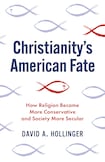
David Hollinger, emeritus professor of history at Berkeley, California, and a self-styled “post-Protestant”, provides an authoritative and fascinating account of how over the past 80 years American “Christianity” was captured by “the most politically, culturally and theologically reactionary Americans”.
Long before white evangelical Protestants and conservative Catholics contributed to the surprise election of Donald Trump in 2016, Richard Nixon and Ronald Reagan had also enjoyed the support of white Christian nationalism, significantly funded according to Hollinger by anti-regulation and anti-tax big business in concert with wealthy individuals.
Since the 1960s two branches of American Protestants have competed for followers: ecumenical Protestantism, which accommodates scientific, ethno-racial modernity; and evangelical Protestantism, a safe harbour for white people hostile to civil rights legislation and sexual liberation. Evangelism has become the largest Protestant religion in the US thanks to a long line of charismatic preachers, such as the Southern Baptist Billy Graham, who preach a message of white entitlement and a Protestant United States.
This book explains how “the evangelical takeover of Christian real estate was financed by corporate interests eager to exploit ‘religious liberty’ as an instrument for overturning the regulatory regime of the New Deal.” For example, they financed the evangelical magazine Christianity Today, which helped to sustain this unholy alliance by calling for “a more militant voice in the Cold War, and consistent defence of laissez-faire free enterprise economics as the sole Christian pattern, and theological conservatism.”
EU call to stockpile food and essentials: What would be in your 72-hour survival bag?
Adolescence in teenagers’ own words: ‘Parents have absolutely no idea’
Trocadero restaurant review: A timeless classic that is old-school in the best sense
Irish Tesla owners on Musk’s EV company: ‘I’m either stuck with it, or I have to take a big financial hit’
Following president Lyndon B Johnson’s and Democrats’ support of the anti-Jim Crow Voting Rights Act in 1965 (“There goes the south,” Johnson sighed on signing the act), the corporate bosses of the Republican Party saw an opportunity for more reliably winning the Electoral College. They stoked up racist fears among white evangelicals to rally support for the Republican Party in the south and rural parts of midwestern and mountain states.
In contrast, ecumenical Protestants, mainstream Catholics, African American Baptists, Jewish Americans and religiously unaffiliated Americans became more affiliated with the Democratic Party, creating the “ethno-religious polarisation” that has become an enduring feature of American public life.
The book explains how abortion became an issue in US elections from the 1980s, leading to the Supreme Court reversing Roe v Wade earlier this year: “Casting about for other issues with which to attract white evangelicals, especially in states where the defence of racial segregation was not a priority, Republican politicians settled on abortion.”
Despite scant Biblical support for an anti-abortion position, evangelicals rallied to the cause, joining with then president Reagan who reversed his earlier support for reproductive freedom. In more recent years, when the scandals of sexual abuse of children in the Catholic and Southern Baptist churches became prominent in the media, American church leaders doubled down on their opposition to abortion, succeeding to some extent in deflecting attention from the scandals.
Today Americans are less religious, with Protestant and Catholic churches seeing smaller congregations except for the south and the west, where Hispanic immigrants boost Catholic membership. Nevertheless, the US has the largest number of Protestants of any country in the world, with Pew Research estimating it as 46 per cent of the population, with Catholics at 20 per cent, secular at 30 per cent and the remainder a mix of other religions.
Hollinger may have underestimated the backlash against the disproportionate political clout of white evangelicals who represent only 14 per cent of Americans overall. The midterms highlighted a division in the churches regarding abortion rights, with voters in California, Kentucky and Michigan opting to protect abortion rights in ballot propositions. An Edison Research exit poll showed that abortion was the biggest driver of the vote for 76 per cent of Democrats, many of whom are religious but believe in social justice and freedom of choice. John Fetterman, who supports abortion rights, could hardly have succeeded in the Pennsylvania Senate race without a significant number of Catholic and Protestant votes.
The failure of Republicans to exploit the ironclad rule that the party in power loses the midterms indicates that the Democratic base of moderate voters showed up, spurred by the reversal of abortion rights after 50 years and the fear that other democratic rights were under threat. This base included women, young people and religious Americans who were appalled by the Maga extremists and religious zealots. The organisation Catholic Democrats urged “good Catholics” to bring “an understanding – into and out of the ballot booth – of the call to solidarity (Pope Francis calls it our word) in advancing God’s Kingdom on earth with a charity of heart.”
Hollinger concludes this valuable book by wondering why, if religious ideas are relevant to public policy, they are not subject to critical evaluation. The author quotes legal journalist Linda Greenhouse that the effective ban on questioning religious belief in the US “has been a gift to the religious right: the secular middle does not know how to talk back or even frame the questions”.
The solution lies in restoring the separation of church and state while respecting all and no religious beliefs. But it remains to be seen if the Republican Party, having failed to win the Senate and with only narrow control of the House of Representatives, will continue to enact evangelical and Catholic doctrine in federal and state laws, or, recognising voter resistance, pull back to a less extreme position.











